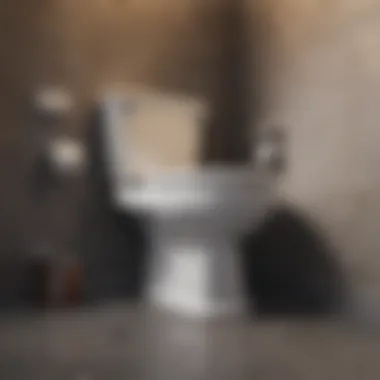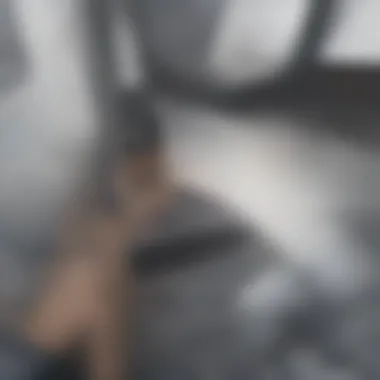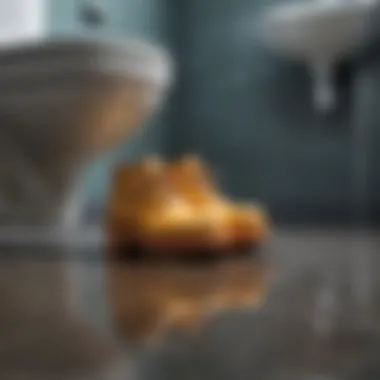Unclogging Your Toilet: Effective Techniques and Tips


Intro
In the realm of home maintenance, experiencing a clogged toilet can be a frustrating event. Knowing how to navigate these plumbing challenges efficiently is essential for homeowners. This article delves into effective methods for unclogging toilet drain pipes. From understanding common causes of clogs to outlining practical solutions, it aims to equip readers with the necessary knowledge to manage these issues confidently.
Several factors contribute to toilet clogs. Understanding these can help in both prevention and resolution. These issues include excessive toilet paper usage, foreign objects, and even build-up of minerals. Recognizing these can serve as a basis for adopting preventive measures.
This article will cover actionable steps that homeowners can take. Whether you are a DIY enthusiast or someone new to home repairs, these solutions are designed to be accessible. Additionally, the discussion will touch upon when it is appropriate to seek professional plumbing assistance.
Through this exploration, readers will find detailed techniques and suggestions to regain control over their bathroom plumbing. The goal is to empower individuals to address clogs effectively while fostering an understanding of the plumbing systems at work in their homes.
Preamble to Toilet Drain Clogs
Understanding toilet drain clogs is crucial for any homeowner. A clogged toilet can disrupt daily life and lead to unpleasant situations. Knowing how toilet systems work and the factors that lead to clogs can prevent common issues and save the cost of repairs. This section will explore the basics of toilet drain systems and the typical reasons clogs occur, laying a solid groundwork for understanding how to effectively address these problems.
Understanding Toilet Drain Systems
To grasp the issue of clogs, one must first understand how toilet drain systems function. A typical toilet consists of several key components: the toilet bowl, the tank, and the drainage pipe. When a toilet is flushed, water from the tank flows into the bowl, forcing waste through the S-shaped trap and down the drain. This trap is designed to retain water, preventing sewer gases from entering the home.
It is essential that this mechanism operates smoothly for proper drainage. The pipes connected to the toilet lead to the main sewer line, which ultimately directs waste away from the house. Any disruption in this flow can result in a clog, leading to inefficient drainage or complete backups.
Common Reasons for Clogs
Clogs can arise from various sources. Some of the most frequent culprits include:
- Excessive Waste: Flushing large amounts of toilet paper or non-flushable items can cause blockages.
- Foreign Objects: Things like toys or hygiene products can inadvertently make their way into the toilet.
- Grease Build-Up: Over time, grease from oils or other materials can accumulate in the pipes.
- Mineral Deposits: Hard water can lead to deposits forming in the pipes, narrowing the flow.
- Old Pipes: Aging plumbing systems may become more susceptible to clogs.
By recognizing these factors, homeowners can take proactive steps to maintain effective drain function and avoid the inconvenience of clogs. The next sections will delve into prevention strategies and practical methods to address issues as they arise.
Preventive Measures
Preventive measures play a crucial role in maintaining toilet drain pipes and minimizing the inconvenience of clogs. By adopting specific practices, homeowners can significantly reduce the chances of encountering serious blockages. This section explores the best practices for toilet use and regular maintenance techniques that can preserve the functionality of your plumbing. The benefits are clear: less frequent repairs, improved hygiene, and cost savings over time.
Best Practices for Toilet Use
Utilizing the toilet properly can greatly impact its drain function. Here are some effective habits to consider:
- Only flush toilet paper: Flushing anything other than toilet paper can lead to clogs. Items like wipes, feminine hygiene products, and even excessive amounts of paper can accumulate and obstruct pipes.
- Teach children proper toilet habits: Educating young family members on what can and cannot be flushed is essential. Encouraging them to ask questions can prevent future issues.
- Limit flushing food waste: Some households might use toilets for waste disposal. Always use appropriate systems for disposing of food and do not flush leftovers or scraps down the toilet.
By implementing these practices, the risk of significant clogs can be minimized, making your toilet system run more efficiently.
Regular Maintenance Techniques
Regular maintenance is key to sustaining a healthy toilet drain. Here are several techniques that homeowners should integrate into their routines:
- Routine Inspections: Periodically check for leaks or signs of wear around your toilet. Catching issues early can prevent tiny problems from becoming major repairs.
- Flush Regularly: To keep the pipes clear, flushing the toilet regularly helps wash away any potential build-up. This is especially important for toilets not used often.
- Utilize Biological Cleaners: Instead of harsh chemicals, consider using biological cleaners that break down debris. This is not only effective but can also be gentler on your plumbing system.
- Mineral Build-Up Prevention: If you live in areas with hard water, consider using a descaling product periodically to prevent mineral deposits from forming in your toilet pipes.


Incorporating these regular maintenance techniques creates a proactive approach to plumbing issues. By being vigilant and taking small steps, you can preserve the health of your toilet drain pipes and reduce the frequency of clogs.
Identifying the Clog
Identifying the clog is a crucial step in addressing toilet drain issues effectively. Recognizing the signs early can save time and prevent further complications. A well-timed intervention can sometimes avoid a minor issue from escalating into a significant plumbing crisis. Homeowners who understand the indicators of a clog can act swiftly and implement solutions before the situation worsens.
Signs of a Clogged Toilet
Several signs may suggest that your toilet is clogged. Early identification is key to effective resolution. Common indicators include:
- Slow Drainage: If water takes longer than usual to swirl down, or rising water levels follow flushing, this could signal a blockage.
- Unusual Noises: Gurgling sounds can indicate trapped air. This might suggest that the drain is partially obstructed.
- Overflowing: If water starts to overflow from the toilet bowl, this is a clear and urgent sign that a clog exists.
- Frequent Backups: Multiple instances of backflow or slow drains can signal a persistent problem in the plumbing system.
Recognizing these signs can lead to prompt action, potentially preventing more complex issues.
Determining the Severity of the Clog
Understanding the severity of a clog is vital for choosing the right method for resolution. Not all clogs are equal, and assessing their severity can prevent unnecessary damage to the plumbing system. Here are a few factors to consider:
- Duration: How long has the issue persisted? A longstanding clog may indicate a deeper problem.
- Location: Is the clog affecting the toilet only, or is it causing issues in other areas of the home? If multiple fixtures are slow to drain, the problem may be much larger.
- Type of Blockage: Is it a foreign object causing the clog, or could it be due to a buildup of waste? Specific blockages may require distinct approaches.
Determining the severity can help in deciding whether to attempt a DIY solution or consult a professional plumber. Proper assessment leads to more successful outcomes and can save on potential repair costs later.
Tools for Unclogging
Selecting the appropriate tools for unclogging is an essential step in effectively addressing toilet drain issues. The right tools can make the process smoother and increase the chances of successful unclogging. Proper tools not only simplify tasks but can also minimize potential damage to your plumbing system. Most homeowners may find basic tools sufficient, but understanding when to escalate to advanced options is crucial.
Essential Tools for Homeowners
Every homeowner should have a set of basic tools at their disposal for plumbing emergencies. Here are the most vital tools:
- Plunger: A standard cup or flange plunger is fundamental. It generates pressure that can often dislodge blockages effectively.
- Toilet Auger: This is a specialized tool designed to reach deeper clogs. It consists of a flexible cable and a crank handle, making it ideal for persistent blockages.
- Gloves: Wearing sturdy rubber or latex gloves is necessary for hygiene. They help protect your hands from dirt and bacteria during the unclogging process.
- Bucket: Keeping a bucket nearby is practical in case of overflow. It can also be used to catch any water or waste during the process.
- Wet/Dry Vacuum: If available, this can be useful for suctioning out water or debris from the toilet bowl before attempting to unclog.
These tools are usually accessible and can handle most common clogs efficiently. Having them on hand can save time and reduce frustration.
Advanced Tools for Persistent Clogs
In some cases, standard tools might not suffice. Advanced tools can be essential for addressing more serious blockages:
- Drain Snake: This tool is effective for tough clogs and is often longer and more flexible than a toilet auger. It allows homeowners to reach further into the drain system.
- Hydro Jet: This professional-grade tool uses high-pressure water jets to clear severe blockages. It’s not commonly used by homeowners but can be a worthwhile consideration for professional plumbers.
- Cameras for Inspection: A camera can aid in diagnosing the problem. It allows for visual inspection of the pipes without invasive methods, helping to identify the cause of a blockage.
Investing in these advanced tools may be necessary for persistent or recurring clogs. They tend to be more costly but can ultimately save time and prevent further issues.
It's essential to assess the situation properly before deciding on tools. Each home is unique, and clogs can vary in severity.
Understanding which tools to use and when can improve one’s plumbing experience significantly. Preparations with the right equipment not only empower homeowners but also bring peace of mind knowing they are equipped for potential plumbing dilemmas.
Step-by-Step Unclogging Methods


Understanding how to effectively unclog a toilet drain pipe is critical for homeowners. It not only saves time and money, but also prevents potential damage caused by persistent clogs. Therefore, learning the various methods for unclogging ensures that everyone is equipped with the knowledge to address these plumbing issues efficiently.
Using a Plunger Effectively
The plunger is one of the most common tools found in household plumbing. Its simplicity belies its effectiveness. To use a plunger properly, follow these steps:
- Choose the right plunger: A flange plunger, designed specifically for toilets, works best.
- Prepare the area: Clear any items around the toilet to prevent dirt or debris from entering the toilet.
- Create a seal: Place the plunger over the drain hole, ensuring a tight fit. This seal is vital to creating the necessary pressure.
- Push and pull: Use quick, forceful thrusts to dislodge the clog. Repeat this action several times to allow pressure to build up.
- Flush: After a few tries, flush the toilet to see if the problem is resolved.
By using a plunger effectively, homeowners can easily tackle minor clogs and restore normal function to their toilets without resorting to harsh chemicals.
Employing a Toilet Auger
When a clog persists despite plunging efforts, the toilet auger becomes a valuable tool. This device features a flexible cable that can reach farther into the drain pipe to remove stubborn obstructions. Here’s how to use it:
- Insert the auger: Carefully push the auger into the toilet bowl, aiming for the drain.
- Rotate the handle: Twist the handle to extend the cable deeper into the pipe. This action allows it to break up any blockage along the way.
- Push through: If you encounter resistance, gently push through, continuing to rotate the handle.
- Withdraw the auger: Once you feel the blockage clear, pull the auger back out.
- Flush: Finally, flush the toilet to confirm the clog is gone.
A toilet auger is a more powerful solution for deeper and more resilient clogs. Its effectiveness helps to tackle situations where simple plunging may fall short.
Chemical Drain Cleaners: Pros and Cons
Chemical drain cleaners are seen as quick fixes, but they come with their own set of advantages and disadvantages that every homeowner should consider.
- Pros:
- Cons:
- Speed: They can quickly dissolve clogs without much physical effort.
- Availability: These products can be found in most hardware stores and are easy to use.
- Damage to plumbing: Harsh chemicals can corrode pipes over time, particularly in older plumbing systems.
- Health risks: Many chemical cleaners release harmful fumes and require proper protective equipment during use.
Homeowners must weigh these pros and cons before relying on chemical drain cleaners. Knowing when and how to use them is essential for maintaining the integrity of plumbing and ensuring safety.
Effective unclogging involves choosing the right method for the right situation. Consideration of tools and techniques may greatly influence the outcomes in tackling toilet clogs.
When to Seek Professional Help
In any household, addressing plumbing issues can range from straightforward problems to complex scenarios that require specialized skills. It is crucial to recognize when a DIY approach is not yielding results and when it is time to call in a professional plumber. Ignoring these signals may lead to further complications, resulting in more significant damage and higher repair costs.
Professional assistance is necessary when the clog seems persistent despite repeated attempts to clear it. Signs of serious underlying issues include multiple clogged drains in the home, foul odors emanating from the toilet or drains, and water backing up in sinks or tubs. These situations could indicate a deeper plumbing problem requiring expert diagnosis and resolution.
Considering the health risks, plumbing professionals have the training and tools to safely address such issues. They can identify problems that most homeowners might overlook, such as tree root intrusion, damaged pipes, or sewer line blockages. Seeking help from a professional not only ensures the problem is resolved efficiently but also affords peace of mind knowing the work is done correctly.
Recognizing the Limits of DIY Solutions
While many homeowners have practical skills and can handle basic plumbing tasks, there are still limits to what can be achieved without professional aid. Some techniques may provide temporary relief, but they do not address the core issue. For example, using a plunger may work for minor clogs, yet this may not clear deeper obstructions.
If repeated use of a plunger does not yield results, the situation may require other methods, such as a toilet auger or professional-grade drain cleaners. Additionally, certain circumstances, like construction debris or large objects lodged in the pipes, can be dangerous to handle without proper expertise.


Homeowners should also consider the potential hazards linked to chemical drain cleaners. Although these products might seem like an easy fix, they can lead to further damage if overused or applied inappropriately. More seriously, chemical exposure can pose health risks if not handled properly. In light of these factors, knowing when to stop is as crucial as knowing how to start.
Choosing a Plumbing Professional
When it becomes clear that professional help is necessary, the next step is to choose the right plumber. Selecting a qualified professional can significantly impact the outcome of the plumbing repairs. First, check their credentials. A licensed plumber is more likely to have received proper training and to adhere to safety regulations and standards.
Additionally, obtaining referrals from friends or family can aid in finding reliable professionals. Online reviews and ratings can provide insight into the quality of service a plumber offers. It’s essential to ask them about their experience with the specific issue at hand, as different plumbers may specialize in various aspects of plumbing.
Once potential candidates are identified, request detailed estimates, including a breakdown of labor and materials involved. A reputable plumber should be transparent about their pricing structure. Also, pay attention to their availability and response times, especially for urgent situations.
Overall, making informed choices when selecting a plumbing professional will lead to a better outcome and restore functionality to your toilet drain system with less hassle.
Key Takeaway: Knowing when to seek professional help is crucial. Recognizing the limits of DIY methods and carefully choosing a qualified plumber can save you from potentially greater issues.
Post-Clearing Considerations
Once you successfully unclog a toilet, the journey does not end there. It is crucial to consider various post-clearing strategies to ensure that the issue does not recur. This section explores key elements that help in maintaining the functionality of your toilet drain pipes after a clog has been cleared.
Monitoring for Recurrent Issues
Monitoring your toilet after unclogging is essential. Sometimes, a clog can seem resolved, but underlying problems may persist. Here are some signs to watch for:
- Frequent clogs: If you notice that the toilet clogs again soon after clearing it, this might signal deeper issues with the drain line or the sewer system.
- Unusual sounds: Gurgling noises when flushing could indicate air trapped in the system, which often means a more serious obstruction is present.
- Slow drainage: If the toilet water drains slower than normal, it might suggest that the problem is not fully fixed. This could lead to a future clog.
To effectively monitor, consider keeping a log of any issues. Document dates and observations which can assist in identifying patterns that may warrant professional attention.
Further Preventive Strategies
Once the clog is cleared, implementing preventive strategies can greatly reduce the risks of future issues. Here are some actionable methods to consider:
- Regular Inspections: It is wise to periodically check your toilet and its components. Look for any signs of leakage or wear and tear, particularly in the flush mechanism.
- Educate Household Members: Ensure that everyone in the household uses the toilet appropriately. Refrain from flushing items that are not meant to go down the toilet, such as wet wipes, personal hygiene products, or excessive amounts of toilet paper.
- Use Enzyme Cleaners: Consider using enzyme-based drain cleaners regularly. These products are effective in breaking down organic materials without harming the plumbing system.
- Install a Drain Cover: Using a drain cover can prevent larger debris from entering the system. Ensure it fits securely and is easy to remove for cleaning.
Implementing these strategies can enhance the longevity of your toilet’s plumbing system and enhance overall home maintenance efficiency.
By remaining vigilant and proactive, you assure that your toilet remains functional, which is vital for a well-maintained home.
Culmination
In the discussion surrounding toilet drain clogs, recognizing the significance of effective methods for unclogging is crucial. This article outlined various techniques, underscoring each one’s relevance in practical scenarios for homeowners. Exploring methods like plungers, toilet augers, and even the cautious use of chemical drain cleaners, the aim is to equip readers with knowledge and skills. Through these techniques, individuals can tackle issues independently before resorting to professional help.
One benefit highlighted is the empowerment of homeowners. Understanding how to address a clog not only saves money in potential plumbing fees but also enhances confidence in managing household maintenance. Furthermore, recognizing when to seek help ensures that plumbing problems do not escalate.
"An informed homeowner is a proactive homeowner."
Regular maintenance and monitoring can lead to fewer emergencies, contributing to overall home care. Thus, the conversation about unclogging toilet drains serves as a gateway to broader discussions about home upkeep.
Summarizing Key Points
- Recognizing different methods to address clogs helps in quick resolution of plumbing issues.
- Effective use of tools like plungers and augers can prevent serious problems.
- Knowing when to seek professional assistance can save time and resources.
- Regular maintenance is a reliable way to avoid future clogs and plumbing emergencies.
Final Thoughts on Toilet Maintenance
Toilet maintenance extends beyond mere unclogging methods. Ongoing attention to usage habits, maintaining plumbing health, and implementing preventive measures are indispensable practices for homeowners.







